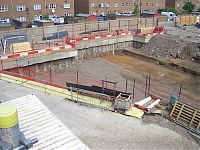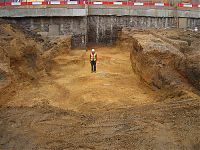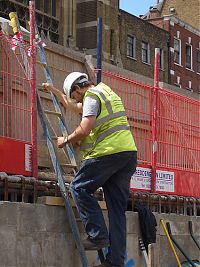Field Officers Report for period ending 22nd May 2008
Posted under: journal >> Reports- By: Chaz Morse |
- May 29, 2008
- Share
- del.icio.us

The excavation of area 1 was completed on the 16th May. The archaeology in this western area of the site was comprised of four main periods of activity. The latest was the late post-medieval housing and associated drainage features such as soak-aways, drain runs, silt traps, and wells. The amount of such features in a relatively small area is indicative of the rapid population increase in the region during the late post-medieval period.
Additionally the amount of these features on the site area provided many windows into the surrounding stratigraphy. This revealed a large number of pits, with many having been large quarry pits, with lower backfill dated to the 1480’s. The earliest and largest of the quarry pits Context: 639 had a lower backfill that had many leather of cut inclusions and approximately 15 shoes Context: 642. The nature of these inclusions indicate that majority of these deposits were dumped cobblers waste. The preservation in this pit was remarkable, arguably resulting from the capping layers of gravels overlying organic material that sealed in moisture creating an environment condusive to the survival of fragile material.
Once fully excavated the largest quarry pit was found to have a significant depth of c.2.4m below ground level, and a diameter of c.5.5m.
Islands of surviving Roman archaeology were found between these quarry pits, with burials and cremation urns from the Roman cemetery featuring to the east of the quarry pits. The preservation of the inhumations was fairly poor, as a result of the acidic sands into which the burials were dug.
The earliest recorded event on site was a palaeochannel or periglacial channel Context: 873 in the south of area 1. The channel was sampled and drawn in section, and we will pick up the further extent of it to the east in area 2 to produce a plan of its line across the site area. However as a result of the heavy truncation on site, its survival is limited.


